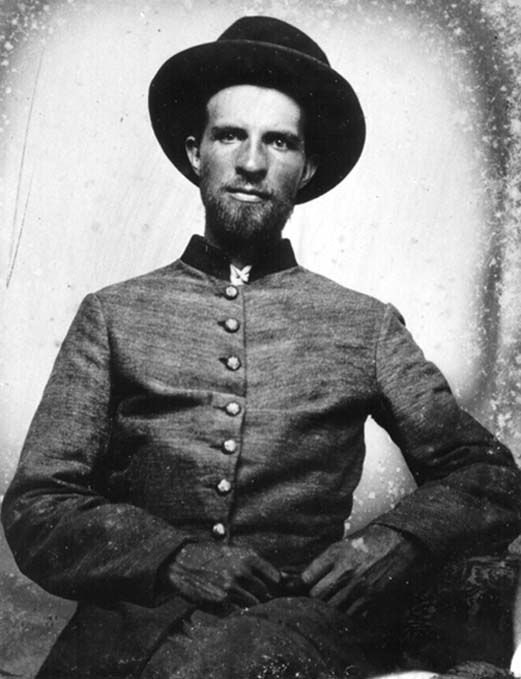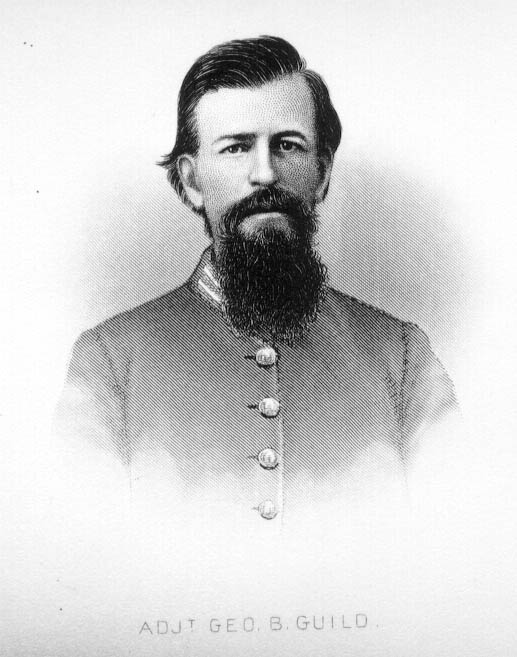Go To Related Neal-Moore Cemetery
The Following Thread by Karen Moore Waugh
My Great Grandfather Captain George C. MOORE served in
the 4th TN Cavalry under the men you have pictured. Their names are on his
war department record which follows:
Record of Captain George C. Moore from War Department:
George C. Moore, Seargent, Co H4 (Murr's) Tennessee Cavalary, Confederate
States Army, enlisted July 22, 1861, at Nashville, age 28 years.
This company became Co C 8 (Smith's) Tennessee Cavalry. Elected 1st Lt.
May 18th 1862, and promoted to Captain August 1st, 1863.
His name appears as signature to an oath of Allegiance to the US and
shown that he surrendered May 2nd, 1865, at Charlotte, NC and subscribed to
the Oath on May 19th, 1865, at Nashville, TN.
His description is recorded as follows: dark complexion, dark hair, grey
eyes, 6ft. 2 inches tall. Place of residence, Smith County.[1861 photo above]
Officers: Battles:
Baxter Smith - Col. Shiloh
Paul Anderson - Lt. Col. Perryville
Wm. Scott Bledsoe - Major Murfreesboro
George B. Smith - Adjutant Lookout Mt. (Battle Above the Clouds)
Marcelle Grissim - Capt. (wounded here**)
W. F. Delaney - Surgeon Dalton, GA
William Boone - Capt. Tunnel Hill
W. T. Allen - Asst. Surgeon New Hope Church
W. S. Rushing - Sgt. Major Marietta
J. A. Stewart Atlanta, Newman
Jas. Nance - Buglers, Co. A "March to the Sea"
Griswoldsville
Buck Head Church
Saltville, VA
Fayetteville, NC
Chapel Hill, NC
Bentonville, NC
Charlotte, NC (Surrendered)
Horse stolen by Yankees on the way home - had to walk. The Government
paid him $200 for the horse 20 years later. [see official report below]
*********
NOTE: The B.H. MOORE listed by Mr. Clark with the 7th's materials was
Capt. George MOORE's brother, William H. "Buck" Moore. The T. J. Estes
listed with the 7th was Capt. George Moore's brother in law.
******
Also, this from another Smith Co. CSA searcher, Bill Allen:
"A Brief Narrative of the Fourth Tennessee Cavalry Regiment" by George B.
Guild is a regimental history of Smith's regiment written about 1912-1913.
It was reprinted in 1996 by Cool Springs Press, Franklin, TN, and I have a
copy of this reprint. As I recall, they printed 2500, and were selling them
for about $25. This was more the personal reminisces of Guild, and there is
some history missing, particularly for a period in 1864 when the regiment
was split.
Pages 158-159 list the killed, wounded, died of Company C, and Capt. George
C. Moore is listed as wounded. Page 159 says, "Capt. George C. Moore was
well known in the Regiment as the "Old Reliable," and was always at his
post. He died a few years ago at New Middleton, Tenn."
There were three different 4th TN Cavalry regiments - generally known as
(1) Smith's (officially the 8th TN Cav), (2) Starnes'-McLemore's
(originally the 3rd), and (3) Murray's. I have a little info on all 3 -
county origins of each company of each regiment, plus service summary. I
have g-gfathers who served in Smith's Co A, "the Marshall Rangers" from
Marshall Co (Dr. Thomas A. Allen); and Starnes'-McLemore's Co D (William
Alpheus Hunter), also a Marshall/Bedford Co unit; therefore, I know more
about these two. Also, a brother of my g-gfather (William G. Allen), served
in Starnes-McLemore's Co A, also a Marshall Co unit.
My g-gf, Dr. Thomas A. Allen, was in Smith's Co A, "the Marshall Rangers,"
and he was regimental assistant surgeon.
I checked my files, and I find that another person contacted me about a
veteran of Company C. Following is a copy of his message:
I am primarily a seeker of info. on the 4th (8th) Cav. One of my wife's
g.g. grandfathers, Robert Ewing Harris, was a Corp. in Co. C.of Baxter
Smith's old 4th. He enlisted 22 July, 1861, at Nashville. He has only one
muster roll card on record, one from 1 Sept. 1862 through 28 January 1863.
It reads: " Absent W/O permission, Furnished his own horse. Resigned 16, May
1862." Mr. Harris (b. 30 March, 1825,
d. 2 May, 1900) apparently went off to W. VA with the unit, and then went
home when
they returned to the Middle Tennessee area. He was a resident of eastern
Wilson County, and Co. C consisted of men from just across the county line in
Smith County. Thanks to some distant cousins, I have extensive info. on the
Harris family, but no more info. his Confederate service, or his reason for
leaving. He had a wife and four daughters under the age of 10 at home, and a
5th daughter (my wife's g.grandmother) would be born
in November. Perhaps he was ill, or just couldnt be away from home any
longer. I'll probably never know.
Allen Sullivant
Brentwood, TN
******
And another Smith County CSA tidbit:
My name is Paul Mengelberg. My g-grandfather Joseph S. Cato joined "H"
Co. of Murray's 4th Tennessee Cavalry on July 21,1861. He was from Smith Co.
It later became "C" Co. under Baxter Smith's 8th. That is about the extent
that I've been able to find on my g-grandfather except that he was shot the
day after Lee surrendered and lost his right arm. They were in Fayettevile,
N.C. My great aunt knew of many stories but passed away before I was able to
hear any of them. One story she told my mother was that once after being
captured by the North, my g-grandfather was being transported on a flat boat
on the Cumberland River close to where he was raised. When the opportunity
arose, he jumped overboard and swam away while being fired upon.
I've just purchased the George B. Guild book. He was mentioned once in
the section of wounded. He was only 15 years old when he joined. He was
discharged July 1865 in Willmington N.C.
I understand that your g-grandfather was Captain George C. Moore. He
would have been my g-grandfathers captain. If there are any sites, books, or
information that you could pass on to me I would be very greatful.
(Later)
Ted & Karen,
Thank you both for some of the info that you've passed on to me. This
past weekend I visited a distant cousin who lives in Lebanon, TN in Wilson
Co. He showed me the square where they have a statue of General Hatton and
gave some history of him and the area. He told of a time when John H. Morgan
visited Lebanon and was almost captured by the Yankees. He was chased all the
way to Rome, Tn where he escaped across the ferry on the Cumberland river.
His horse got away from him while crossing and was taken by a yankee general.
The ferry at Rome where Morgan crossed was at a bow in the river that was my
Ggrandfather's family's farm. It was called Denny's Bend.
We also went to a farm in Rome where some confederate soldiers, who were
home on leave, were called out, stood up next to their family's smoke house
and executed by yankees right in front of their mother and father. The smoke
house is still standing with the buckshot holes still visible. The Grisham
boys are buried there in the next field.
I found out that my Ggrandfather's sister-in-law was the heroine
mentioned by Bromfield L. Ridley in "Battles and Sketches of the ARMY of
TENNESSEE". Miss Helen Price Cato, 14 years old, hid a squad of Morgan's men
who were being persued by Colonel Funkerhauser's regiment. She hid them on
an island in the Cumberland river and also fed them until the yankees gave up
and returned to Lebanon.
My Ggrandfather was captured at the battle of Shepherdsville Oct. 3,
1862. His company muster roll showed that at one time he was due $50 bounty.
Do either of you know what bounties were paid out for? I'm gather a lot of
information that I hope will let me determine exactly what battles my
Ggrandfather found in etc.
Thank you both
again, Paul Mengelberg
*****
And about those stolen horses and the goverment payment....
Karen:
Thanks for the picture and here is what happened according to Major Guild.
On the 26th of April, 1865, General Johnston surrendered his army of
about 20,000 men to General Sherman. General Johnston had issued the
following , which was read to the different commands.
Terms of a military convention entered into the 26th day of April, 1865,
at Bennett's house, near Durham station, N.C. between Gen Joseph E. Johnston,
commanding the Confederate Army, and General W.T. Sherman , commanding the
Untied States army in North Carolina:
!. All act of war on the part of troops under General Johnston command to
cease from this date.
2. All arms and public property to be deposited at Greensboro, and
delivered to an ordnance officer of the United States.
3. Rolls of officers and men to made in duplicate, one copy to be
retained by the commander of the troops and the other to be given to an
officer to be designated by General Sherman. Each officer and men to give his
individual obligation in writing not to take up arms against the United
States until properly released from this obligation.
4. The side arms of officers and their private horses and baggage to be
retained by them.
5. This being done, all officers and men will be permitted to return to
their homes, not to be disturbed by the United States authorizes so long as
they observe these obligations and the laws in force where they may reside.
Joseph E. Johnston, Commanding
Confederates.
W.T. Sherman, Commanding United
States Forces.
Supplemental terms of the same date, signed by these officers, recite among
other things: "Sections F. Private horses and private property of both
officers and men to be retained by them"
In order to expedite the printing of paroles the Confederate cavalry
under General Wheeler were sent to Charlotte, NC. where they received their
paroles on May 3, 1865.
After this the troops scattered to their homes. The First Tennessee
Cavalry Regiment , the Ninth Battalion of Tennessee, and a greater part of
the Fourth Tennessee left in body, as they resided in middle Tennessee. We
were provided with some rations; but after traveling some distance, we found
that it would be necessary to forage upon the country. For the purpose of
lightening the burden upon an almost improvised people, we separated, the
First Regiment and the ninth Battalion taking the road to the right. crossing
the East Tennessee Railroad at Strawberry Plains, and the Fourth Tennessee
crossing at the Sweetwater. At these places on the railroad the commands were
halted, and order was presented from General Stoneman ( with headquarters in
Knoxville) to dismount the men, take their horses, and ship them by rail to
their homes. Of course a protest was made against this proceeding, as it was
expressly provided for by the terms of the articles of the surrender that the
horses were the private property of the men and they were allowed to keep
them. Forty years after this unwarranted proceeding the Congress of the
United States passed an act to pay these soldiers for their horses and
equipment---to wit; One Hundred and Twenty-five dollars for the horse and ten
dollars for the saddle and bridle. This act was limited to soldiers that were
paroled at the surrender of the Confederate army, and in case of death, to
the widows.Where there was no widow, the children were to receive the
benefit.The act provided also that the taking must have been done by the
United Sates soldiers. Many have availed themselves oaths long deferred
justice, and in many cases it has benefited them and their families immensely.
About may 20, 1865 the Middle Tennessee soldier reached Nashville to
proceed to their homes.
Taken from the History of the Fourth Tennessee Cavalry by Major George Guild.
*******




